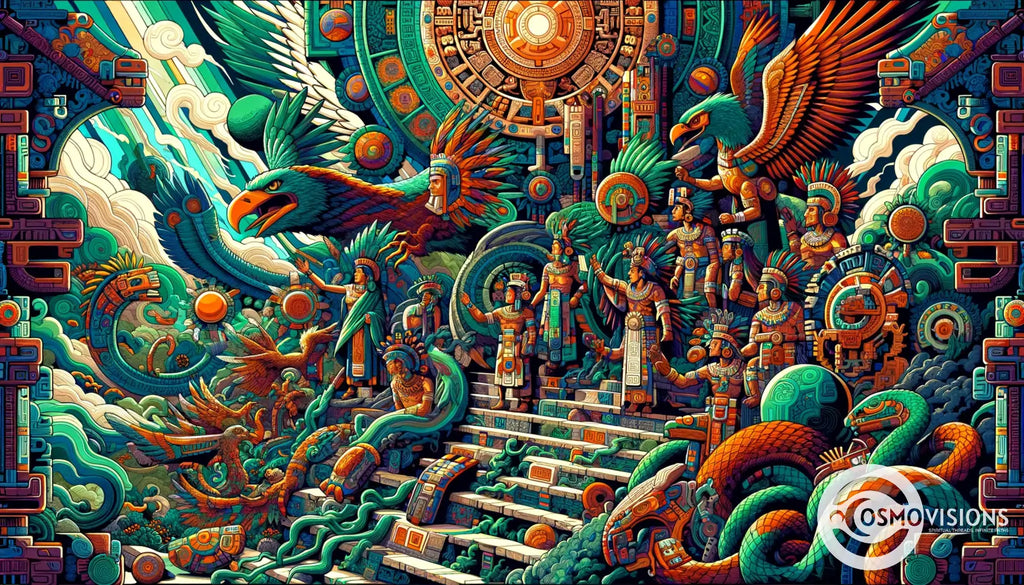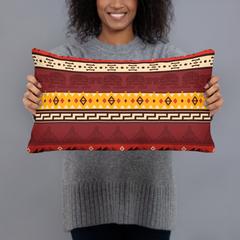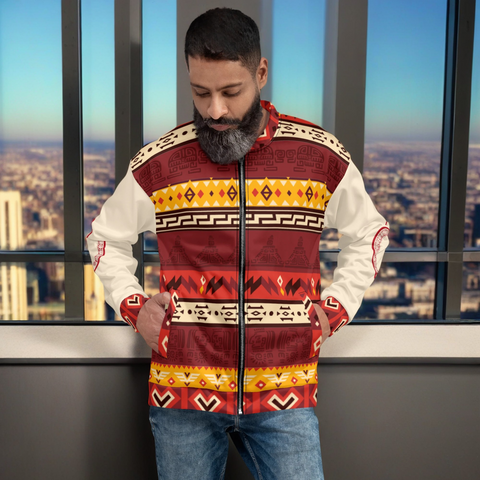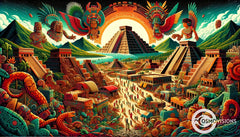Unveiling The Aztec Government: Inside The Aztec Empire's Political System
Posted by Massimiliano Geraci

Aztec society had a clear system where everyone knew their place. The highest ranks, called tecuhtli, were the big bosses like generals and judges. They even included the emperor and gods of their religion. The elected headmen of Calpullis formed a city council with executive members who held power in overseeing the smooth functioning of the cities and advising the emperor.
Common folks, known as maceualli, could climb up if they showed bravery in battles. A group called capullec took care of farms and asked advice from wise elders named ueuetque.
The church was super rich with lots of lands and buildings. Emperors and people gave it fancy gifts. Laws in Aztec times were tough with different punishments for each social class.
This setup made sure everyone did their part to keep society running smoothly.
What defined the class system in Aztec society?
The class system in Aztec society was clear-cut, separating people into nobles and commoners. Nobles, or “tecuhlti,” enjoyed positions of power such as generals, judges, leaders, and even aztec emperors.
They even included the emperor and the gods they worshipped. This elite group oversaw major decisions within the empire’s governance and religious practices. Their roles were critical in maintaining order and enforcing laws across Tenochtitlan.
Commoners, known as “maceualli,” formed the backbone of Aztec civilization. Despite their lower status, bravery in battle could elevate them within societal ranks. Each district had a head called a “capullec,” chosen for life by the emperor himself - showing that merit could triumph over birthright at times.
The interesting blend between hereditary privilege and earned respect defined social mobility among the Aztecs, making their hierarchy both rigid and dynamic.
The role of the nobility and priesthood within Aztec culture
Nobles and priests held great power in Aztec culture. Nobles, known as tecuhtli, included top warriors, leaders, and judges. Their children, called pilli, also served as officials or envoys for the emperor.
This class controlled the government and religion, shaping major decisions within the empire.
Priests played a key role too. They were not just religious leaders but also part of the government’s backbone. The high-priests had equal standing with powerful nobles and even advised the emperor. The two high priests, Quetzalcoatl totec tlamacazqui and Quetzalcoatl tlaloc tlamacazqui, were in charge of the cult to the Huitzilopochtli and the rain god Tlaloc, respectively.
Together, these groups maintained order and led important ceremonies that kept society together. They made sure people followed traditions that honored their gods and ancestors.

How the macehualtin shaped the backbone of Aztec civilization
The macehualtin were the heart of Aztec civilization, working as farmers, artisans, and merchants. They grew crops, made goods, and traded – fueling the empire’s economy. Their hard work supported everyone, from nobles to soldiers. The Aztec army, composed largely of these commoners, played a crucial role in conquests and military activities.
Some showed great bravery in battles for new lands or defending their own. These heroes could rise in status. The macehualtin did not just feed the empire with their farms or fill its markets with crafts; they were warriors who could change their stars through valor. Courage in battle offered them a rare chance to climb Aztec society’s ladder. This system ensured that even commoners had hope for greatness if they showed exceptional courage or skill in war.
Through their various roles within the community units called calpulli, these common people also upheld crucial social structures - teaching younger generations and taking part in religious activities that kept traditions alive.
Aztec Nobility and the Pipiltin: Holders of Power and Privilege
Aztec leaders and pipiltin stood at the top of society. These people included high officers, area rulers, judges, and even the emperor himself. Their children, known as pilli, were trained to take on important roles like being ambassadors or officials for the empire.
This class lived in grand style. They owned large homes, wore fancy clothes, and enjoyed special rights.
Their power stretched into both politics and religion. High priests held great influence, serving on councils that chose new emperors. The executive council, consisting of four members including the city leader, played a significant role in overseeing the city and its surrounding areas. They also managed vast lands belonging to the temple and received generous gifts from both rulers and common folks.
Education was crucial for young nobles. They attended special schools where they learned about leadership, warfare, and sacred rites. These schools prepared them to command armies or lead ceremonies that pleased their gods.
Life and responsibilities of the noble class in Tenochtitlan
Nobles in the Aztec city of Tenochtitlan had big jobs. They led soldiers, judged disputes, and helped rule the empire. These leaders were called tecuhtli, holding places of honor in society. Their children, known as pilli, also took on important roles.
The emperor chose them to be judges or ambassadors.
Each neighborhood had a leader called the capullec, chosen for life. This leader ensured land was used well for farming and listened to advice from wise elders. High priests shared power too, guiding the emperor with their wisdom.
The Aztec church played a key role in government decisions as well.
The influence of pipiltin on Aztec political and religious spheres
Pipiltin, the Aztec nobles, had a big impact on both politics and religion in their empire. These high-ranking people held major positions like generals and leaders in Tenochtitlan. The influence of the Aztec god Huitzilopochtli, the god of war and the sun, significantly shaped their religious practices.
They were chosen by the emperor for important jobs. This included being judges or diplomats. Their roles gave them a lot of power over laws and military actions.
In religion, pipiltin also played key parts. Some became high-level priests with great influence. The church owned lots of land because emperors and citizens gave it gifts. These noble priests helped pick the next emperor too, showing how mixed politics and religion were in Aztec life.
Educational and military pathways for the Aztec nobility
Aztec nobles went to special schools called Calmecac. These schools taught them about leadership, religion, and military strategies. Teachers were wise and respected members of society who prepared students for important roles in the Aztec empire.
Students learned how to read ancient codices and understood the stars, which was key for their religious practices.
Nobles also trained as warriors from a young age. They joined military groups where they learned fighting skills and bravery. They had to capture enemies during battles to become leaders or earn higher ranks.
This training made them strong leaders who could protect their land and people.
The Commoner Classes: Macehualtin and Their Roles
Farmers, artisans, and merchants made up the backbone of the Aztec empire. They worked hard to grow food, create beautiful things, and sell goods. This effort kept the economy strong.
A group called calpulli was key for them. It helped manage land and work in a way that kept communities close.
Social mobility was a real thing for these commoners. Bravery in war could lift someone up in society.
The pochteca were special among merchants. They traveled far, bringing back rare items and information. Their journeys made them powerful but also put them at great risk. Because of their roles as traders and gatherers of intelligence, they enjoyed a unique place in Aztec culture.
Aztec farmers, artisans, and merchants: Sustaining the empire's economy
Aztec farmers grew maize, beans, and chilies. These crops fed the empire. Artisans made beautiful pottery and jewelry. They used turquoise and gold. Merchants traveled far to trade these goods.
They brought back feathers, cocoa, and precious stones.
These workers kept the economy strong. Farmers gave food for everyone to eat. Artisans created things that showed Aztec spirit and wealth. Merchants spread Aztec influence by trading across lands far from Tenochtitlan, their great city on a lake.
Their work helped make the empire rich and powerful.
Social mobility: How commoners could rise in Aztec society
In Aztec society, commoners known as maceualli had ways to climb the social ladder. One major path was showing courage in battles. Warriors who captured enemies could gain respect and higher status.
This bravery did not go unnoticed by those in power.
Each district of Tenochtitlan was under a leader called capullec, chosen for life and approved by the emperor. These leaders managed farmlands and listened to advice from a group of wise elders named ueuetque.
Through hard work and valor in warfare, a commoner could rise up, becoming an influential figure within their community and beyond.
Calpulli: The foundation of Aztec communal life and labor
Calpulli made up the heart of Aztec community life. Families in a calpulli shared their lives and work, like farming, weaving, or building. This system made sure everyone did their part for the good of all.
The chief or capullec, chosen by the people, looked after land and resources within each calpulli. This way of living brought members closer together.
This unity went beyond just working side by side. People in a calpulli also took care of social and spiritual duties that connected them to the wider Aztec empire and its beliefs. Being part of a calpulli meant playing an important role in both day-to-day survival and bigger ceremonies that honored the gods.
Through this blend of labor and faith, each member contributed to the stability and growth of their society.
The Pochteca: Merchants and Spies of the Aztec Empire
The Pochteca played a key role in the Aztec Empire. They were elite merchants, organizing themselves into groups called guilds. These traders did not just sell items; they traveled far to bring back rare luxury goods in Central Mexico.
Their journeys made them valuable to the rulers because they also gathered secrets about other places and people. This double life as spies helped the empire grow stronger and richer.
Pochteca had privileges others did not enjoy, like not having to fight as soldiers or pay taxes. Their work increased their influence and made them unique in Aztec society. Because of what they did, the empire could control more land and have more power over its neighbors.
Being part of this group meant you played a role in ensuring the Aztec civilization stayed wealthy and powerful through trade and information gathering.

The wealth, power, and danger of being an Aztec merchant
Aztec merchants, known as pochteca, were wealthy and powerful. They traveled far to bring precious items back to the Aztec empire. These goods included cacao, gold, and exotic feathers.
Pochteca had a special place in society because their work helped the empire grow rich.
However, being a pochteca was also risky. They often went on long journeys through dangerous lands full of enemies. If caught by rivals, they could be killed or taken as slaves. Despite the dangers, their role was vital for connecting the Aztec world with distant cultures and territories.
To walk in wealth as a pochteca was to tread a path lined with both gold and danger.
Pochteca: Their role in expanding Aztec influence beyond Central Mexico
Pochteca were key to growing Aztec power far from Central Mexico. These traders went on long journeys to get luxury items, news, and new tech from far places. They reached lands now known as Guatemala, the American Southwest, and even parts of the Caribbean.
Their guilds made them strong by connecting them with political and economic networks.
These merchants were highly respected for bringing wealth and growth to the Aztec realm. Through their trade routes, they brought back goods and shared cultures across Mesoamerica.
Their work made the Aztec Empire a big regional force, showing how trading can change an empire's reach and influence.
The unique social status of pochteca in Aztec society
Specialized traders, known as pochteca, held a rare and honored place in Aztec culture. They were not just merchants but also adventurers who journeyed far to bring back exotic goods and luxury items that dazzled the Aztec elite.
Their roles went beyond simple trade; they acted as diplomats and political envoys, forging vital connections with distant lands and city-states. This set them apart from commoners and even some of the nobility, giving them a distinct layer within the societal fabric.
These traders enjoyed privileges like owning land and having servants, which were rights usually reserved for higher social classes. With their wealth, they could influence politics and religion in Tenochtitlan.
Despite these advantages, they existed outside traditional noble circles—respected for their contributions yet viewed with suspicion for their extensive travels and interactions with foreign cultures.
They organized into guilds led by a pochtecatl—a leader wielding significant power—and lived in their own districts, highlighting both their importance to the Aztec economy and their unique place in its hierarchy.
Aztec Education and Military Training Across Classes
The Aztec empire had schools called Telpochcalli and Calmecac where both commoners and nobles learned important skills. Commoners, or maceualli, and nobility trained side by side in these places.
They all prepared for battle because fighting was a big part of moving up in society. Bravery in war could turn a commoner into a leader.
Teachers taught students how to be warriors and about their culture's deep beliefs and traditions. This training mixed learning with physical strength, ensuring every student could contribute to the empire’s power.
Education shaped future leaders, judges called tecuhtli, and skilled soldiers ready to expand their land through conquests. From young ages, everyone knew that doing well here was key to climbing the social ladder within the vast Aztec government system.
The Telpochcalli and Calmecac: Training grounds for commoners and nobility
Young boys in the Aztec empire went to two types of schools: Telpochcalli for commoners and Calmecac for nobility. At Telpochcalli, commoner boys learned skills for battle and government work.
They prepared to serve their community and protect the empire. Nobles sent their sons to Calmecac, where teachers trained them in leadership, religion, and military strategies. This education ensured they could take on important roles within their society.
Training at both institutions was crucial for shaping future leaders of the Aztec political system. Boys who excelled could climb up the social ladder, sometimes reaching positions of power previously thought impossible for their class.
Through rigorous schooling, they became respected officials or mighty warriors ready to defend or expand the empire's reaches beyond Central Mexico.
Roles and significance of military training in Aztec society
Military training in Aztec society was a key to power and respect. Sons of the high-ranking tecuhtli, known as pilli, got chosen for important battle roles by the emperor. This shows how vital military skills were for climbing the social ladder.
Commoners also had a shot at rising up if they proved their bravery in fights. Being strong and courageous in battles could change a commoner's life and move them up in society.
Aztecs valued warriors highly because they expanded and protected the empire. Training wasn't just about fighting; it was about loyalty to the empire and its leaders. The council of nobles, experts in war tactics, advised on battles that helped grow Aztec lands.
Military prowess linked directly to how much influence one could have.
Valor on the battlefield opened doors to power within the Aztec world.
How education and training influenced social hierarchy and mobility
Education and training allowed Aztecs to move up in their social world. Schools like the Telpochcalli trained young commoners in warfare and crafts, laying a foundation for them to gain status through bravery or skill.
For nobles, the Calmecac offered deeper knowledge in leadership, astronomy, and religion. This system created chances for all to alter their place within society.
As warriors showed valor or craftsmen mastered their trade, they earned respect and could shift from lower standings to positions of influence. The tribute system also played a part, as successful military campaigns brought wealth and captives from other lands under Aztec control.
Through these efforts, individuals could rise, showing how tightly education, training, and societal advancement were linked in the Aztec empire.
The Influence of Religion on Aztec Social Hierarchy
Religion shaped every part of Aztec life, including who held power. Priests and nobles stood at the top because they were close to the gods. They led ceremonies and decided on wars, which kept their positions strong.
Commoners could sometimes join this high rank by becoming priests. This path was one of a few ways for them to move up in society.
Beliefs about gods made these rules seem right to everyone. Religious events reminded people of their place in the social ladder. Sacrifices and battles had religious reasons that helped keep order.
Even the emperor listened to priests, showing their huge influence. Religion bound the empire together, making it strong inside and out.
The priesthood: A path to power for both nobles and commoners
In the Aztec empire, becoming a priest opened doors to great influence for everyone, from highborn to the humble. Nobles and commoners alike could climb the ranks of spiritual leadership.
The highest priests, known as tlenamacac, held special roles. They even helped pick the emperor, making them very powerful in both religion and politics.
The church owned much land and buildings. Emperors and people gave it rich presents. Through these gifts, the church became wealthy and strong within Aztec society. Priests guided ceremonies that honored gods and played key parts in deciding who would lead next.
This mix of wealth, power, and sacred duty placed priesthood at the heart of Aztec life.
Aztec gods and religious ceremonies: Reinforcing social stratification
Aztec gods played a huge role in their society. These divine beings shaped every part of Aztec life, including the empire's strict social ladder. Priests, who were very important people, held ceremonies to honor these gods.
Offerings and sacrifices during these events showed everyone's place in society. Nobles got closer to the altar than farmers or merchants could ever dream.
Religious festivals made the social order clear to everyone. People saw nobles and priests perform special tasks that commoners couldn't, keeping everyone aware of their place within the empire's hierarchical structure.
Such rituals reminded commoners of their duties and limits under the watchful eyes of both their rulers and deities.
Introduction
Understanding the complex world of the Aztec government might seem hard at first. Many people find it tricky to grasp how this ancient empire managed its lands and people so effectively.
Yet, uncovering the inner workings of their political system is a fascinating journey. One key fact stands out: the leader, known as the "tlatoani," played a central role in shaping the empire’s future.
Our blog will guide you through this intricate system, from its foundation to how it influenced daily life in the Aztec Empire. We'll explore everything from social structures and roles within society to military training and religious beliefs that justified their way of organizing society around war and sacrifice.
This peek into history will help you understand how they governed and why their strategies were successful for them.
Get ready to travel back in time…
Key Takeaways
-
The Aztec Empire had a clear social system where warriors could rise in rank through bravery, and commoners, known as maceualli, formed the empire’s backbone by farming, trading, and fighting.
-
Nobles and priests held great power, guiding political decisions and religious ceremonies. High-ranking nobles played key roles in choosing new emperors and managing vast temple lands.
-
Education was crucial for Aztecs. Noble children attended Calmecac to learn about leadership and sacred rites while commoner children went to Telpochcalli for military training. This education prepared them for future roles in society.
-
Religion deeply influenced the Aztec social hierarchy. Priests commanded respect across all classes and led important ceremonies reinforcing the empire's strict social structure.
-
The Pochteca were elite merchants who traveled far to trade valuable goods. Their journeys boosted the economy and helped expand Aztec influence beyond Central Mexico through spying and forming alliances with distant territories.
Exploring the Structure of the Ancient Aztec Government
Dive into the world of the ancient Aztec government to see how leaders and rules shaped a powerful empire. Learn about Altepetl and Calpulli, key parts of their system. Marvel at the Huey Tlatoani's role as both leader and spiritual figure.
Join us to discover more!
Understanding Altepetl and Calpulli: The Foundations of Aztec Administration
Altepetl and Calpulli were key to the Aztec government's structure. The calpulli started as groups of families who owned land together and cared for each other's needs. Over time, these family groups changed, especially in big cities like Tenochtitlan.
Here, calpullis became more about where you lived than your family ties. Each district had a leader known as a capullec, chosen for life and approved by the emperor himself.
The altepetl was a larger unit that included many calpullis. It was a city-state ruled by an elite class or dynasty rather than just one ruler with absolute power. This system allowed different parts of the empire to manage their own affairs while still answering to central authority in Tenochtitlan.
Unity and diversity coexisted within the fabric of Aztec administration through the balance between altepetl and calpulli structures.
The Power of Huey Tlatoani: Leadership within the Aztec Empire
The Huey Tlatoani stood at the top of the Aztec political pyramid. He had the last word on warfare, trading, and sharing resources. This ruler wasn't just a man; people saw him as holding divine power.
His decisions shaped the empire, from expanding territories to managing daily life in Tenochtitlan.
To keep his empire strong, the Huey Tlatoani chose officials known as telpochcalli. These officials taught young boys how to be future leaders or warriors. These boys learned not just about fighting but also about leading their people with wisdom and courage.
The training they received prepared them to uphold the Aztec tradition of strength and honor.

Analyzing the Tribute System's Influence on the Aztec Empire
The tribute system was like the heart of the Aztec empire, keeping it strong and alive. Conquered lands had to pay for goods or work for protection and resource access. This way, the Aztecs ensured their city-states, such as Tenochtitlan, grew rich and powerful.
Leaders like the great speaker used this wealth to strengthen their army and expand their land.
Conquered peoples weren't always happy about paying tribute. They did keep some freedoms but often felt resentful. This anger played a big part when Spanish conquistadors arrived. Many joined them to fight against the Aztec rulers.
The tribute system built the empire's wealth and sowed seeds of discontent that would later help bring its downfall.
Examining the Role of the Triple Alliance in Aztec Governance
The Triple Alliance brought together Tenochtitlán, Texcoco, and Tlacopan and took charge of central Mexico. This coalition was more than just a partnership; it shaped the Aztec Empire's leadership.
Tenochtitlán led this group, with its emperor overseeing vast territories. Together, these city-states built an empire through military might and strategic alliances.
Councils in these cities played a huge role, too. Each calpulli (a group of families) had leaders who met to decide important matters. This setup allowed the emperor and his advisors to manage lands far beyond their capital city.
The Triple Alliance grew strong and wealthy with such a system, dominating their neighbors around Lake Texcoco and beyond.
Conclusion
Peeking into the Aztec government reveals a world where power and spirituality merged like rivers. Leaders lived in grand homes, guiding their people with wisdom from the gods. Brave commoners could rise high if they showed courage.
Rich lands fed by hardworking hands supported this vast empire. This peek behind the curtain shows us how deeply faith wove into the fabric of their society, making every decision sacred.
FAQs
1. What kind of government did the Aztecs have?
The Aztecs operated under a unique system, where an emperor ruled with divine right. This means people believed their leader was chosen by the gods. Their government was centered in the grand city of Tenochtitlan, within the heart of the Valley of Mexico.
2. Who helped run the vast Aztec Empire?
In addition to the emperor, a council of four wise leaders and various city councils managed daily affairs and made big decisions. These groups worked together to keep order across lands stretching to the Pacific Ocean.
3. Did warriors play a role in Aztec politics?
Yes! In fact, military societies were key to expanding their empire and maintaining power. Brave Aztec warriors fought not just for land but also captured enemy soldiers for religious sacrifices.
4. How did religion influence Aztec government?
Religion was deeply woven into their politics; it guided laws and even warfare decisions. The state religion honored many gods, with rituals performed by rulers and common folks.
5. Was there any form of justice or law in place?
Absolutely! They had a complex court system, including special courts for different issues, like trade disputes or more serious crimes, and a Supreme Court as part of the power structure overseeing the markets. And yes, they even had appellate courts to review cases!
6. How did other cities fit into this empire?
Many city-states paid tribute—meaning they gave goods or services—as part of being protected by and included in this powerful empire's network... Each major area contributed to making this civilization rich and diverse.





















